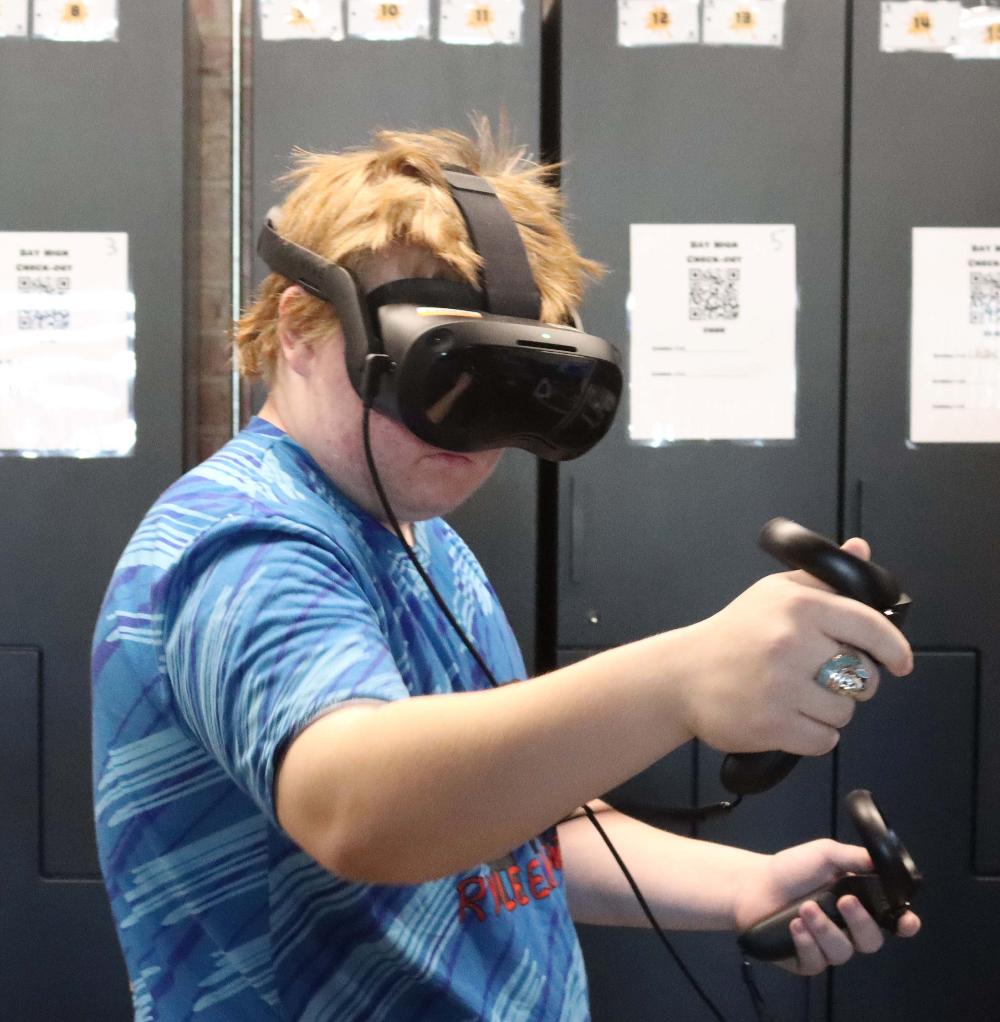Bay High students expand creative concepts with new VR equipment
December 19, 2024
The learning gears for Bay High Focus Program junior Rylee were spinning in full force this fall as he used virtual reality (VR) equipment to animate a cartoon scene.
Rylee and other Lincoln Public Schools students are increasing their computer science knowledge this year through new VR technology systems. The devices are helping them prepare to enter the workforce in a wide variety of careers.
Rylee spent one morning at Bay High building an animated scene with the VR digital program. He donned a headset and attached hand controls before entering the virtual world. He was able to create heroes and villains, change colors of background scenery and see how everything looked in a three-dimensional format.
“I was sketching my character and I was figuring out how he looked in different angles, so it was really cool to see that and be able to physically have it there,” Rylee said. “It was really nice to be able to use that resource.”
Rylee said having access to VR equipment at LPS will boost his future prospects. He is planning to pursue a major in animation and a minor in computer programming when he attends college.
“As a 17-year-old, it’s really cool to get use of these technologies,” Rylee said. “I don’t have it at home, so it’s really cool to come to school and be able to use these newer things and be able to learn before going out and trying to test it out myself.”
Brent Jarosz said computer science is an integral part of the curriculum at Bay High, which is a focus program with classes on marketing, entrepreneurship and journalism. Students are using the VR equipment in a course called Digital Media and Design. The course, which is also available at all eight LPS high schools, introduces them to technical tools and processes that are used in digital design.
“Technology is always changing, so we have to be able to adapt to that,” Jarosz said. “Our kids are really good at it, but they only see as much as they get to, so it’s nice having that new technology within our classrooms and getting kids hands-on experience that they’ll eventually get to see in the workplace.”
The VR equipment meets the emerging technology piece of new legislation that state senators first passed in 2002 and revised in 2023. The law requires all Nebraska school districts to include computer science and technology education (CSTE) programs for K-12 students by the 2025-26 academic year. Beginning in 2027-28, school districts shall require each student to complete at least five high school credit hours in CSTE prior to graduation.
Students can complete the new requirement either through a single course or a combination of classes that cover CSTE academic content standards. School districts can offer the CSTE courses in a traditional classroom setting, a blended-learning environment or a technology-based format.
Jarosz said the VR equipment meets the emerging technology piece of the new state academic standards. Students first take an introductory VR lesson where they try out the headsets and hand controls. They then create items such as virtual houses, snowmen and spaceships in a second lesson that emphasizes imagination and experimentation.
“They think it’s cool that they get to do it in school,” Jarosz said. “They really like the equipment; they think it’s really cool. They really want to do more.”
Bay High junior Graham said he has enjoyed working with the 3D modeling aspect of the VR system. He spent one morning building a campfire scene. He used one VR tool to make little rocks to surround the campfire, and he then employed a fire tool to draw the flames and smoke.
Graham has used VR technology at his home to play games for the past three years. He said having similar equipment in the classroom is even more exciting because of the educational benefits he is receiving.
“I think it’s very interesting, because it can teach you more hands-on experiences rather than just being told to do something and then you have to do it yourself,” Graham said. “It kind of also gives you the freedom to figure out what you want to do and how you want to execute that.”
Students like Graham and Rylee have also discovered how 2D and 3D projects relate to each other. They begin designing many of their ideas using software such as Adobe Photoshop, InDesign and Illustrator. They are then able to translate those concepts into VR formats, which gives them different points of view to work from.
“If we want to figure out, ‘Okay, so if I’m doing this on paper or if I’m doing this scene in the hallway, let’s just sketch out that scene and let’s see how we can do it moving in 3D space,’” Rylee said. “In the future this technology can be used to do storyboards, but in a 3D plane, so that way you know exactly what you’re going to be doing before you do it.”
Rylee said the integration of VR equipment into the classroom is another reason why he likes coming to Bay High to study every day.
“I really enjoy the creative freedom,” Rylee said. “I’m able to just learn at my own pace and I’m able to work on my personal projects.”
LPS students entering grades 11 and 12 can apply to study at Bay High each year. Visit bayhigh.lps.org to learn more about Bay High and the many educational opportunities there.
Do you have a story idea? Share it with the LPS Communications Team by filling out this form!
Published: December 19, 2024, Updated: December 19, 2024

